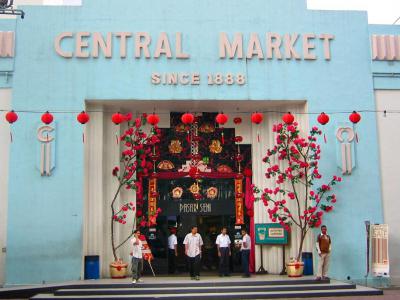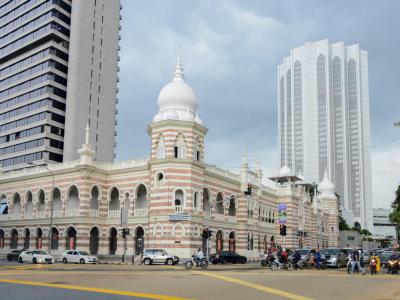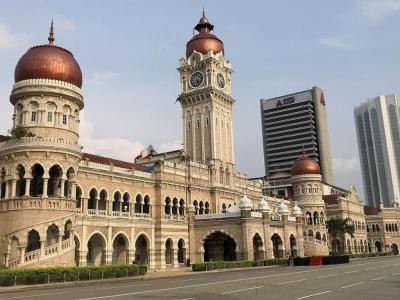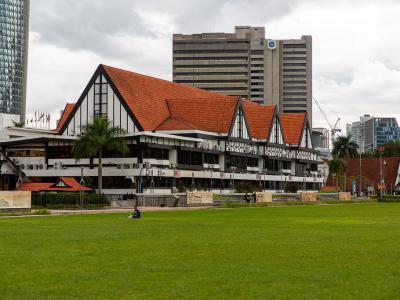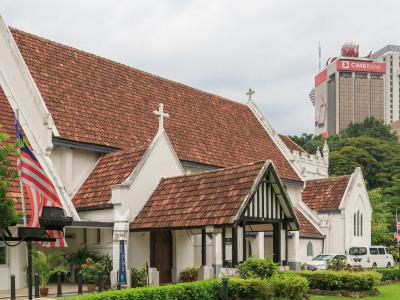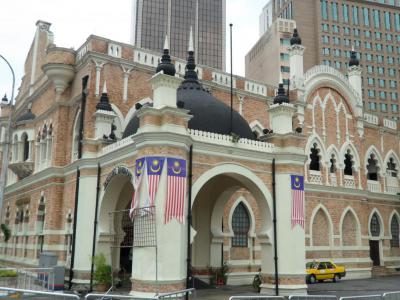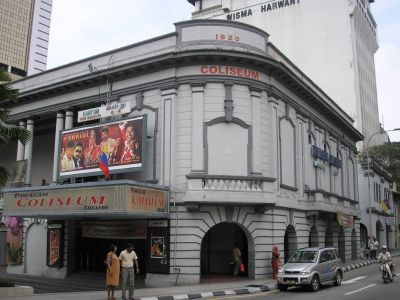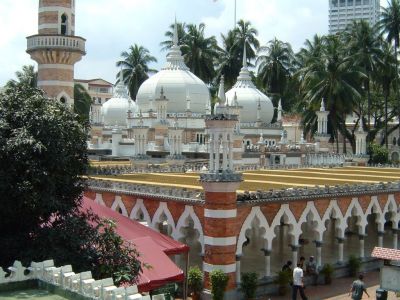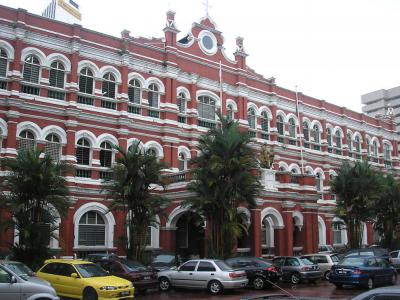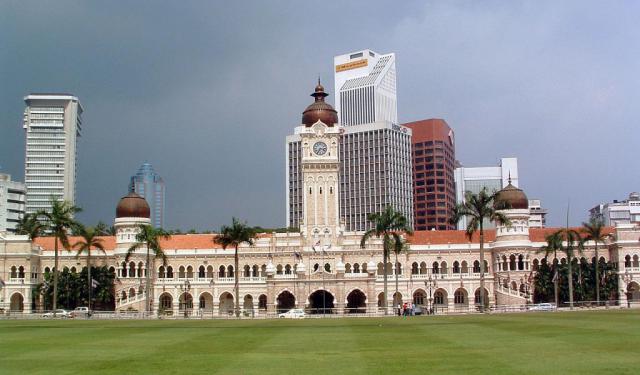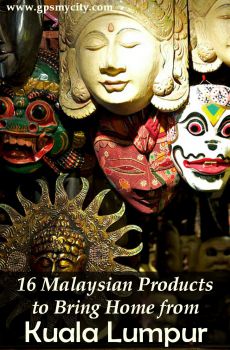Historical Buildings Walking Tour (Self Guided), Kuala Lumpur
A colorful blend of colonial influences, Asian traditions and Malay Islamic inspirations, the historical architecture of Kuala Lumpur is a well known attraction in its own right. Being relatively young a city, most of Kuala Lumpur's buildings date back to the late 19th - early 20th centuries, reflecting Mughal, Tudor, Neo-Gothic or Grecian-Spanish styles. Most of these have been adapted to the use of local resources and climate, which is hot and humid all year around.
The Neo-Moorish and Mughal-style edifices found in the old part of the city are attributed to the greatest colonial power at the turn of the 20th century – Great Britain – and include the Jamek Mosque, Sultan Abdul Samad Building, Bandaraya Theatre, and InfoKraft (the National Textile Museum) among others. The architect directly responsible for or having largely contributed to the design of these buildings was Arthur Benison Hubback.
There is also plenty of the British-built architecture from the early 1900s, such as the Royal Selangor Club, exhibiting Tudor features – the large exposed wooden beams in half-timbered walls, and modified to suit the tropical environment of Malaysia with many days of monsoon rain. The Neo-Gothic influences can be seen in the religious sites like St. Mary's Cathedral, while Victorian architecture – another popular choice during the colonial period – has been exemplified in form of the Central Market, the Coliseum Theater and the likes. St. John’s Institution in Bukit Nanas, famous of its imposing white and red brick exterior, lays emphasis on Grecian-Spanish style of architecture.
To explore these and other magnificent buildings in Malay capital in more detail, take our self-guided architectural walking tour of Kuala Lumpur.
The Neo-Moorish and Mughal-style edifices found in the old part of the city are attributed to the greatest colonial power at the turn of the 20th century – Great Britain – and include the Jamek Mosque, Sultan Abdul Samad Building, Bandaraya Theatre, and InfoKraft (the National Textile Museum) among others. The architect directly responsible for or having largely contributed to the design of these buildings was Arthur Benison Hubback.
There is also plenty of the British-built architecture from the early 1900s, such as the Royal Selangor Club, exhibiting Tudor features – the large exposed wooden beams in half-timbered walls, and modified to suit the tropical environment of Malaysia with many days of monsoon rain. The Neo-Gothic influences can be seen in the religious sites like St. Mary's Cathedral, while Victorian architecture – another popular choice during the colonial period – has been exemplified in form of the Central Market, the Coliseum Theater and the likes. St. John’s Institution in Bukit Nanas, famous of its imposing white and red brick exterior, lays emphasis on Grecian-Spanish style of architecture.
To explore these and other magnificent buildings in Malay capital in more detail, take our self-guided architectural walking tour of Kuala Lumpur.
How it works: Download the app "GPSmyCity: Walks in 1K+ Cities" from Apple App Store or Google Play Store to your mobile phone or tablet. The app turns your mobile device into a personal tour guide and its built-in GPS navigation functions guide you from one tour stop to next. The app works offline, so no data plan is needed when traveling abroad.
Historical Buildings Walking Tour Map
Guide Name: Historical Buildings Walking Tour
Guide Location: Malaysia » Kuala Lumpur (See other walking tours in Kuala Lumpur)
Guide Type: Self-guided Walking Tour (Sightseeing)
# of Attractions: 9
Tour Duration: 2 Hour(s)
Travel Distance: 2.6 Km or 1.6 Miles
Author: valery
Sight(s) Featured in This Guide:
Guide Location: Malaysia » Kuala Lumpur (See other walking tours in Kuala Lumpur)
Guide Type: Self-guided Walking Tour (Sightseeing)
# of Attractions: 9
Tour Duration: 2 Hour(s)
Travel Distance: 2.6 Km or 1.6 Miles
Author: valery
Sight(s) Featured in This Guide:
- Central Market
- Textile Museum
- Sultan Abdul Samad Building
- Royal Selangor Club
- St. Mary's Cathedral
- Panggung Bandaraya DBKL Theatre
- Coliseum Theater
- Jamek Mosque
- St John's Institution
1) Central Market (must see)
Founded in 1888 by the British, the Central Market is one of the best places to visit in Kuala Lumpur. Not only is it one of the prime locations to shop in the city, it is also the best place to enjoy the fruits of a multi-cultural and multi-ethnic environment. Because Kuala Lumpur has a rich blend of diverse cultures and people hailing from different parts of the globe, each have their unique set of handicrafts along with a unique blend that is very Malaysian. The market is one of the most visited sights in the city and quite a popular destination for buying souvenirs and mementoes for your trip.
The market was founded in 1888 and originally used as a wet market, while the current Art Deco style building was completed in 1937. It has been classified as a Heritage Site by the Malaysian Heritage Society and it is now a landmark for Malaysian culture and heritage.
With constant renovations and refurbishment, the market soon had distinct stalls and zones for different ethnic groups to display and promote their items. In the earlier days the Central market was nick named the “wet market” because the floors were constantly wet. The market was visited mainly by tin miners of the region and sold meat, vegetables and the catch of the day!
Today the market mainly sells food, sweets, arts, crafts, bags, t-shirts and souvenirs. It is clean, well lit, easily accessible and conveniently located close to multiple public transport facilities.
The market was founded in 1888 and originally used as a wet market, while the current Art Deco style building was completed in 1937. It has been classified as a Heritage Site by the Malaysian Heritage Society and it is now a landmark for Malaysian culture and heritage.
With constant renovations and refurbishment, the market soon had distinct stalls and zones for different ethnic groups to display and promote their items. In the earlier days the Central market was nick named the “wet market” because the floors were constantly wet. The market was visited mainly by tin miners of the region and sold meat, vegetables and the catch of the day!
Today the market mainly sells food, sweets, arts, crafts, bags, t-shirts and souvenirs. It is clean, well lit, easily accessible and conveniently located close to multiple public transport facilities.
2) Textile Museum
Malaysia is well known for its creative textile art and exquisite fabrics. Famous amongst the fabrics is the Batik style, an age old technique of staining the cloth with wax-resistant dye to produce beautiful patterns. Although the Batik may have established itself outside the boundaries of Malaysia, one would be surprised to discover the various types of traditional textiles, fabric and designs that the country has to display, some of which are much older than the Batik itself.
The best place to educate oneself about the array of local textiles and the art of Batik is the National Textile Museum. It showcases some of world’s rarest and most exquisite textiles. Located at the Jalan Sultan Hishamuddin, the Museum is housed in over a century old heritage building that was previously occupied by various institutes and civil departments.
The Museum is segmented in four well organized galleries, each depicting an era of the Malay textile history and the influence of the varied cultures that added more variety to the fabric of time. Each gallery has a unique story to tell that is sure to keep you captivated till the end. The galleries cover every aspect of textile history; like prehistoric fabric, tools, materials and techniques to present day Batik fabric and its evolution. The Museum also sheds light upon the various cultures along with their respective textiles and fabrics, and explores their influence on the local art. The Museum also showcases some of the most breathtaking jewelry from various parts of the world.
Designed by Arthur Benison Hubback in an Indo-Saracenic Revival architecture, the building was originally completed in 1905 to house the headquarters for the Federated Malay States Railways (FMSR, now KTM). After the FMSR moved to the Railway Administration Building in 1917, the building has subsequently housed various government and commercial occupants, before being converted for use as the National Textile Museum and opened to the public on 9 January 2010.
The building was gazetted as a historical building in 1983.
The best place to educate oneself about the array of local textiles and the art of Batik is the National Textile Museum. It showcases some of world’s rarest and most exquisite textiles. Located at the Jalan Sultan Hishamuddin, the Museum is housed in over a century old heritage building that was previously occupied by various institutes and civil departments.
The Museum is segmented in four well organized galleries, each depicting an era of the Malay textile history and the influence of the varied cultures that added more variety to the fabric of time. Each gallery has a unique story to tell that is sure to keep you captivated till the end. The galleries cover every aspect of textile history; like prehistoric fabric, tools, materials and techniques to present day Batik fabric and its evolution. The Museum also sheds light upon the various cultures along with their respective textiles and fabrics, and explores their influence on the local art. The Museum also showcases some of the most breathtaking jewelry from various parts of the world.
Designed by Arthur Benison Hubback in an Indo-Saracenic Revival architecture, the building was originally completed in 1905 to house the headquarters for the Federated Malay States Railways (FMSR, now KTM). After the FMSR moved to the Railway Administration Building in 1917, the building has subsequently housed various government and commercial occupants, before being converted for use as the National Textile Museum and opened to the public on 9 January 2010.
The building was gazetted as a historical building in 1983.
3) Sultan Abdul Samad Building
The Sultan Abdul Samad Building is undoubtedly one of the grandest structures in the skyline of Kuala Lumpur. Standing proudly at the Jalan Raja, the building emanates authority, heritage and elegance. Located on the opposite side of the Independence Square from the Royal Selangor Club, the Sultan Abdul Samad Building is one of the city's most treasured landmarks.
Built during the British occupation, the structure took shape in 1897. The chief architect responsible for its regal construction was A.C Norman along with chief engineer C.E Spooner. The building was named after the fourth Sultan of Selangor under whose reign the building was constructed, and boasts an excellent blend Indo-Islamic and Neo-Gothic architectural styles. History has it that Norman, in fact, visited India and from the visit drew inspiration for many of his designs.
One of the oldest structures in Kuala Lumpur, the Sultan Abdul Building has been used by the government since its inception and presently houses the Ministry of Information, Communication and Culture of Malaysia. The structure is truly spectacular and definitely worth the visit.
Why You Should Visit:
As majestic as it is during the day, when it is lit up at night, the building looks simply magical.
Tip:
Don't miss the backyard of the Sultan Abdul Samad Building, either. Facing the river, it forms a peaceful garden with tiled fountains and wrought iron benches to relax on. White marble, yellow tiles, and the freshly planted greenery create a harmonious background for the building.
Built during the British occupation, the structure took shape in 1897. The chief architect responsible for its regal construction was A.C Norman along with chief engineer C.E Spooner. The building was named after the fourth Sultan of Selangor under whose reign the building was constructed, and boasts an excellent blend Indo-Islamic and Neo-Gothic architectural styles. History has it that Norman, in fact, visited India and from the visit drew inspiration for many of his designs.
One of the oldest structures in Kuala Lumpur, the Sultan Abdul Building has been used by the government since its inception and presently houses the Ministry of Information, Communication and Culture of Malaysia. The structure is truly spectacular and definitely worth the visit.
Why You Should Visit:
As majestic as it is during the day, when it is lit up at night, the building looks simply magical.
Tip:
Don't miss the backyard of the Sultan Abdul Samad Building, either. Facing the river, it forms a peaceful garden with tiled fountains and wrought iron benches to relax on. White marble, yellow tiles, and the freshly planted greenery create a harmonious background for the building.
4) Royal Selangor Club
Another heritage venue located around the Dataran Merdeka or the Independence Square is the Royal Selangor Club (RSC). Occupying the northern fringe of the square, this social & sports club opposing the Sultan Abdul Samad Building is another monumental structure that is a reflection of the city’s opulence, culture and history.
Founded in 1884, the RSC was initially a tiny wooden building that was strictly used as a social club, where high ranked officials and the elite of the society gathered for an evening of rendezvous, drink and merry. It was in 1890 that the humble edifice of the building underwent an extreme makeover. Taking inspiration from the Tudor style of architecture, the renovated building had more space and an extra floor. The building underwent reconstruction again in 1910 under the leadership of Arthur Benison Hubback, the man behind the Kuala Lumpur Railway Station.
Since its inception, the RSC has been organizing sports activities and other field and track events. It is currently a 'members only' club so you have to be signed in by a member to gain access.
Founded in 1884, the RSC was initially a tiny wooden building that was strictly used as a social club, where high ranked officials and the elite of the society gathered for an evening of rendezvous, drink and merry. It was in 1890 that the humble edifice of the building underwent an extreme makeover. Taking inspiration from the Tudor style of architecture, the renovated building had more space and an extra floor. The building underwent reconstruction again in 1910 under the leadership of Arthur Benison Hubback, the man behind the Kuala Lumpur Railway Station.
Since its inception, the RSC has been organizing sports activities and other field and track events. It is currently a 'members only' club so you have to be signed in by a member to gain access.
5) St. Mary's Cathedral
Standing humbly at Jalan Raja is the Cathedral of Saint Mary the Virgin also known as the Saint Mary’s Cathedral.
The initial structure was built in 1887, and the Church was made entirely of timber. The Church acted as the central point for all the Anglicans around the area to gather and offer their prayers and take part in other spiritual activities. However, with a capacity to accommodate only 95 people, the wooden church soon fell short for its growing number of its parish members. In 1893, the decision to make a bigger church was passed and the hunt for the perfect architect and design started.
Although many contenders came forth with their ideas and concepts none managed to get a unanimous approval and the responsibility was soon given to the Chief Government architect A.C. Norman who proposed a simple yet classic structure inspired by traditional English Gothic architecture. A sum total of $5000 was allotted for the construction of the new building. Apart from that local philanthropists, Yap Kwan Seng and Thamboosamy Pillay, made tremendous contributions for building the Church.
The pipe organ that resides in the Saint Mary’s Cathedral is also worthy of notice. Built by the famous 19th century organ maker, Henry Wills, the organ is definitely one of a kind.
The initial structure was built in 1887, and the Church was made entirely of timber. The Church acted as the central point for all the Anglicans around the area to gather and offer their prayers and take part in other spiritual activities. However, with a capacity to accommodate only 95 people, the wooden church soon fell short for its growing number of its parish members. In 1893, the decision to make a bigger church was passed and the hunt for the perfect architect and design started.
Although many contenders came forth with their ideas and concepts none managed to get a unanimous approval and the responsibility was soon given to the Chief Government architect A.C. Norman who proposed a simple yet classic structure inspired by traditional English Gothic architecture. A sum total of $5000 was allotted for the construction of the new building. Apart from that local philanthropists, Yap Kwan Seng and Thamboosamy Pillay, made tremendous contributions for building the Church.
The pipe organ that resides in the Saint Mary’s Cathedral is also worthy of notice. Built by the famous 19th century organ maker, Henry Wills, the organ is definitely one of a kind.
6) Panggung Bandaraya DBKL Theatre
DBKL City Theatre (Panggung Bandaraya DBKL) stands as a historic theater hall situated adjacent to Merdeka Square in Kuala Lumpur. Its construction commenced in 1896 and concluded in 1904.
This theater was originally located within the venerable Old City Hall of Kuala Lumpur. Both the theater and the Old City Hall were conceived by Arthur Benison Hubback, an architect working under the colonial government. Hubback was also responsible for the design of other colonial structures across the Klang Valley, including the Kuala Lumpur Railway Station and the Jamek Mosque. The primary purpose of DBKL City Theatre was to host stage productions, encompassing plays and musicals.
The theatre holds the distinction of being recognized as a heritage building in accordance with the Antiquities Act, and its Moorish-style façade has been meticulously preserved.
In 1992, a significant fire ravaged the theater's interior, necessitating a complete restoration by the City Hall's designers and builders. During this restoration effort, notable enhancements were introduced, including updates to the furnishings and the sound system.
This theater was originally located within the venerable Old City Hall of Kuala Lumpur. Both the theater and the Old City Hall were conceived by Arthur Benison Hubback, an architect working under the colonial government. Hubback was also responsible for the design of other colonial structures across the Klang Valley, including the Kuala Lumpur Railway Station and the Jamek Mosque. The primary purpose of DBKL City Theatre was to host stage productions, encompassing plays and musicals.
The theatre holds the distinction of being recognized as a heritage building in accordance with the Antiquities Act, and its Moorish-style façade has been meticulously preserved.
In 1992, a significant fire ravaged the theater's interior, necessitating a complete restoration by the City Hall's designers and builders. During this restoration effort, notable enhancements were introduced, including updates to the furnishings and the sound system.
7) Coliseum Theater
Watching a movie in a regular cinema hall is something one can do anywhere, but what if you have the opportunity to watch your favorite movie in the first theatre that was built in the country? Such an experience would be truly exciting, and it awaits you at the Coliseum Theatre in Kuala Lumpur. Built in 1921, the Theatre, like many of the city’s other heritage sites, was the pioneer in the country. The Art Deco-style building is capable of seating 900 people and also features a balcony.
The Coliseum Theatre may not look like a coliseum from the outside, but definitely has the amphitheater vibe on the insides. Launched by a rich and hardworking Chinese immigrant, Chua Cheng Bok, who earned his riches by working in the tin mines of Kuala Lumpur, the Coliseum is still a proud property of the family. Till today, the Theatre is run by the same family.
Although the Coliseum Theatre has been labeled as a heritage site, you can watch your favorite movies at the Coliseum. Functioning ever since the early 20th century, the Theatre has been showing movies nonstop for almost a century, except when the Japanese invaded Malaysia during the Second World War.
All in all a must visit site on your heritage tour of the city.
The famed Coliseum Café and Hotel-a favorite haunt of English playwright and novelist William Somerset Maugham during his stay in British Malaya-are located behind the theatre, just down the road.
The Coliseum Theatre may not look like a coliseum from the outside, but definitely has the amphitheater vibe on the insides. Launched by a rich and hardworking Chinese immigrant, Chua Cheng Bok, who earned his riches by working in the tin mines of Kuala Lumpur, the Coliseum is still a proud property of the family. Till today, the Theatre is run by the same family.
Although the Coliseum Theatre has been labeled as a heritage site, you can watch your favorite movies at the Coliseum. Functioning ever since the early 20th century, the Theatre has been showing movies nonstop for almost a century, except when the Japanese invaded Malaysia during the Second World War.
All in all a must visit site on your heritage tour of the city.
The famed Coliseum Café and Hotel-a favorite haunt of English playwright and novelist William Somerset Maugham during his stay in British Malaya-are located behind the theatre, just down the road.
8) Jamek Mosque
Within the urban skyscrapers, tucked amidst the serene landscape of palm trees is the beautiful Masjid Jamek. Located at the point where the two rivers, Sungei Klang and the Sungei Gombak meet, the Masjid provides an ambiance of tranquility and quiet in the heart of Kuala Lumpur.
Thronged with worshippers on Fridays and with tourists the rest of the days, the Masjid Jamek is a sight one cannot afford to miss in Kuala Lumpur. In its white and brick red appearance with its old school architecture, the Masjid looks quite distinct in the concrete mechanized surrounding. Designed by Arthur Benison Hubback, this building too draws inspiration from the architectural blend that swept the Indian sub-continent.
Built in the early years of the 20th century, the Masjid was inaugurated by the Sultan of Selangor in 1907. For over a century now the Masjid has been the central point for city. For a long time, the Masjid Jamek was the main mosque of Kuala Lumpur. This title was later transferred to the National Mosque that came into existence in 1965. Apart from being the oldest mosque in the city, the Masjid is also the point from where the city of Kuala Lumpur came into being. The Mosque was built at the very site where the early settlers are believed to have settled.
Thronged with worshippers on Fridays and with tourists the rest of the days, the Masjid Jamek is a sight one cannot afford to miss in Kuala Lumpur. In its white and brick red appearance with its old school architecture, the Masjid looks quite distinct in the concrete mechanized surrounding. Designed by Arthur Benison Hubback, this building too draws inspiration from the architectural blend that swept the Indian sub-continent.
Built in the early years of the 20th century, the Masjid was inaugurated by the Sultan of Selangor in 1907. For over a century now the Masjid has been the central point for city. For a long time, the Masjid Jamek was the main mosque of Kuala Lumpur. This title was later transferred to the National Mosque that came into existence in 1965. Apart from being the oldest mosque in the city, the Masjid is also the point from where the city of Kuala Lumpur came into being. The Mosque was built at the very site where the early settlers are believed to have settled.
9) St John's Institution
Another pit stop on the architectural trek around the city of Kuala Lumpur is the Saint John’s Institution located in Jalan Bukit Nanas. A secondary school for boys, the Saint John’s Institute is one of the oldest schools in Kuala Lumpur, where heritage, education and architecture meet.
Serving the city with its top class education, the Saint John’s Institution has a history of providing knowledge and wisdom for over a century. Not only does it have a reputation of being one of the best schools around in the Kuala Lumpur and Malaysia, it was also declared a heritage site in 2010. Representing the Institute is an overshadowing building in brick red and white that has personified education in Kuala Lumpur since 1906.
The excellent Grecian-Spanish architecture not only makes a bold statement but also makes the building worthy of notice. Located in the heart of the city, just adjacent to the Bukit Nanas forest reserve, the school is surrounded by lush greenery and nature giving it a perfect ambiance. Just a stone throw away from another Kuala Lumpur landmark, the Saint John’s Cathedral, this institute is a must visit.
Serving the city with its top class education, the Saint John’s Institution has a history of providing knowledge and wisdom for over a century. Not only does it have a reputation of being one of the best schools around in the Kuala Lumpur and Malaysia, it was also declared a heritage site in 2010. Representing the Institute is an overshadowing building in brick red and white that has personified education in Kuala Lumpur since 1906.
The excellent Grecian-Spanish architecture not only makes a bold statement but also makes the building worthy of notice. Located in the heart of the city, just adjacent to the Bukit Nanas forest reserve, the school is surrounded by lush greenery and nature giving it a perfect ambiance. Just a stone throw away from another Kuala Lumpur landmark, the Saint John’s Cathedral, this institute is a must visit.
Walking Tours in Kuala Lumpur, Malaysia
Create Your Own Walk in Kuala Lumpur
Creating your own self-guided walk in Kuala Lumpur is easy and fun. Choose the city attractions that you want to see and a walk route map will be created just for you. You can even set your hotel as the start point of the walk.
Historical Religious Buildings
Just as the whole of Malaysia, Kuala Lumpur is a culturally diverse and tolerant city where all of the world’s major religions coexist in perfect harmony. Back in the 1800s-early 1900s, along with the large influx of laborers and merchants of different backgrounds, brought in by the British colonization, came the unique sets of faiths and religious systems: Buddhism, Taoism, Hinduism,... view more
Tour Duration: 1 Hour(s)
Travel Distance: 2.0 Km or 1.2 Miles
Tour Duration: 1 Hour(s)
Travel Distance: 2.0 Km or 1.2 Miles
Kuala Lumpur Introduction Walking Tour
Kuala Lumpur, meaning "muddy confluence" in Malay, refers to the city's birthplace at the junction of the Gombak and Klang rivers. Although some Chinese workers were involved in tin mining in the area in the 1840s, it wasn't until 1857 that a town was established here.
Two men in particular have been credited for making outsized contributions to the development of Kuala... view more
Tour Duration: 2 Hour(s)
Travel Distance: 3.1 Km or 1.9 Miles
Two men in particular have been credited for making outsized contributions to the development of Kuala... view more
Tour Duration: 2 Hour(s)
Travel Distance: 3.1 Km or 1.9 Miles
Kuala Lumpur Shopping Tour
Shopping is one of the top activities for those visiting Kuala Lumpur. In this vibrant city there’s something for every taste and budget, from high-end boutiques offering designer labels to the lively street markets drawing crowds with artsy finds and cheap reproductions, where cheap doesn’t necessarily mean a less enjoyable experience.
With a shopping scene as comprehensive as that of... view more
Tour Duration: 2 Hour(s)
Travel Distance: 3.6 Km or 2.2 Miles
With a shopping scene as comprehensive as that of... view more
Tour Duration: 2 Hour(s)
Travel Distance: 3.6 Km or 2.2 Miles
Useful Travel Guides for Planning Your Trip
16 Malaysian Things to Buy as Souvenirs in Kuala Lumpur
"Malaysia, Truly Asia" is what you hear en route to Malaysia. Indeed, there's practically every bit of Asia to be found here, as the country's population is made up primarily of three groups: Malay, Chinese and Indians. Quite expectedly, the diversity of Malaysian handcrafts is...
The Most Popular Cities
/ view all



